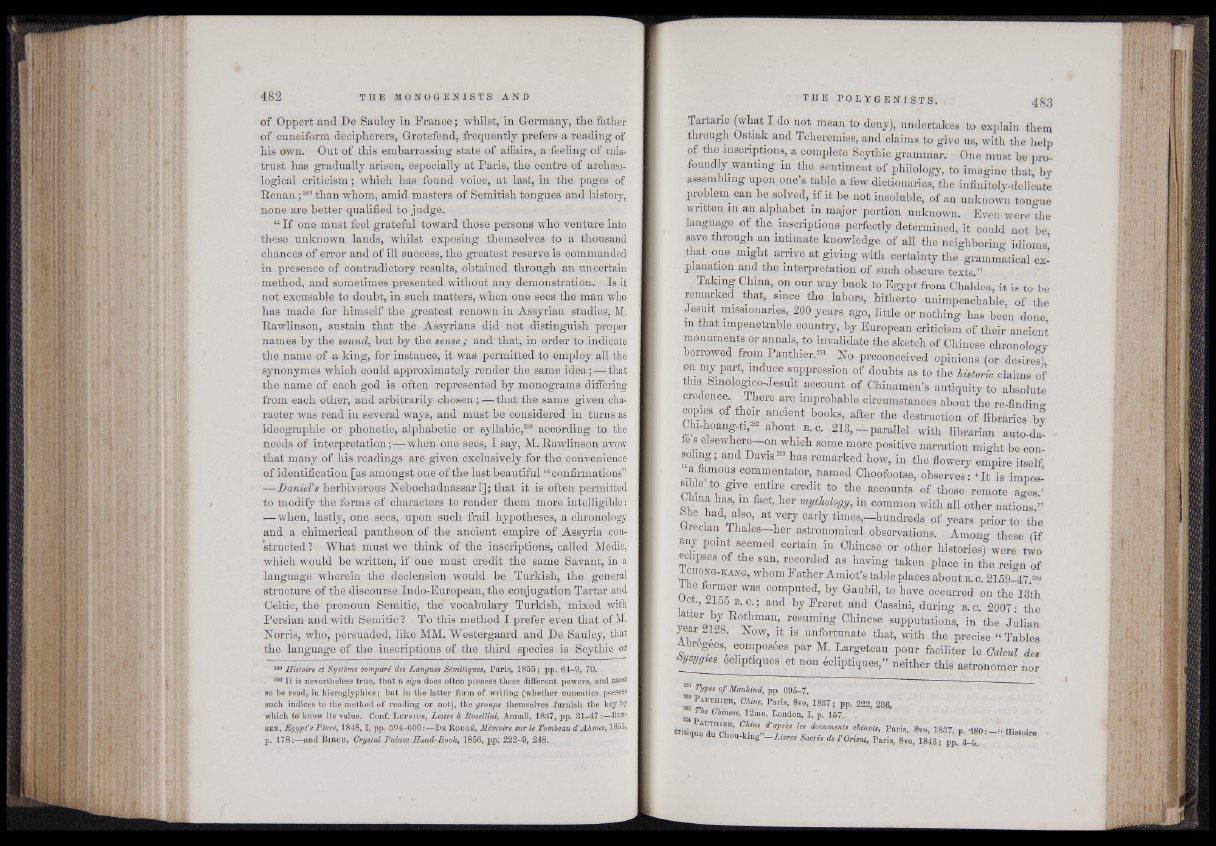
of Oppert and Dé Saulcy in France ; whilst, in Germany, the father
of cuneiform decipherers, Grotefend, frequently prefers a reading of
his own. Out of this embarrassing state of affairs, a feeling of mistrust
has gradually arisen, especially at Paris, the centre of archaeological
criticism ; which has found voice, at last, in the pages of
Renan j249 than whom, amid masters of Semitish tongues and history,
none are better qualified to j udge.
“ If one must feel grateful toward those persons who venture into
these unknown lands, whilst exposing themselves to a thousand
chances of error and of ill success, the greatest reserve is commanded
in presence of contradictory results, obtained through an uncertain
method, and sometimes presented without any demonstration. Is it
not excusable to doubt, in such matters, when one sees the man who
has made for himself the greatest renown in Assyrian studies, M.
Rawlinson, sustain that the Assyrians did not distinguish proper
names by the sound, hut by the sense ; and that, in order to indicate
the name of a king, for instance, it was permitted to employ all the
synonymes which could approximately render the same idea ;-r-that
the name of each god is often represented by monograms differing
from each other, and arbitrarily chosen ; —that the same given char
raeter was read in several ways, and must he considered in turns as
ideographic or phonetic, alphabetic or syllabic,250 according to. the
needs of interpretation;^when one sees, I say, M. Rawlinson avow
that many of his readings are given exclusively for the convenience
of identification [as amongst one of the last beautiful “ confirmations”
—Daniel's herbivorous Nebochadnassar !]; that it is often permitted
to modify the forms of characters to render them more intelligible :
— when, lastly, one sees, upon such frail hypotheses, a chronology
and a chimerical pantheon of the ancient empire of Assyria constructed
? What must we think of the inscriptions, called Medic,
which would he written, if one must credit the same Savant, in a
language wherein the declension would he Turkish, the general
structure of the discourse Indo-European, the conjugation Tartar and
Celtic, the pronoun Semitic, the vocabulary Turkish, mixed with
Persian and with Semitic ? To this method I prefer even that of M.
Norris, who, persuaded, like MM. Westergaard and De Saùlcy, that
the language of the inscriptions of the third species is Scythic or
249 Histoire et Système comparé des Langues Sémitiques, Paris, 1855; pp. 64-9, 70.
250 It is nevertheless true, that a sign does often possess these different powers, and must
so be ready, in hieroglyphics; but in the latter form of writing (whether nuneatics possess
such indices to the method of reading or not), the groups themselves furnish the key by
which to know its value. Conf. L e p s iu s , Lettre à lèosellini, Annali, 1837, pp. 31-47 :—Buns
e n , Egypt’s Place, 1848,1, pp. 594-600:— D e R o d g é , Mémoire sur le Tombeau d'Ahmes, 1851,
p. 178:— and B i r c h , Crystal Palace Hand-Book, 1856, pp: 222-9, 248.
Tartaric (what I do not mean to deny), undertakes to explain them
through Ostiak and Teheremiss, and claims to give us, with the help
of the inscriptions, a complete Scythic grammar. One must he profoundly
wanting in the sentiment of philology, to imagine that, by
assembling upon one’s table a few dictionaries, the infinitely-delicate
problem can be solved, if it be not insoluble, of an unknown tongue
written in an alphabet in major portion unknown. Even were the
language of the inscriptions perfectly determined, it could not be
save through an intimate knowledge of all the neighboring idioms’
that one might arrive at giving with certainty the grammatical explanation
and the interpretation of such obscure texts.”
Taking China, on our way back to Egypt from Chaldea, it is to be
remarked that, since the labors, hitherto unimpeachable, of the
Jesuit missionaries, 200 years ago, little or nothing has been done
m that impenetrable country, by European criticism of their ancient
monuments or annals, to invalidate the sketch of Chinese chronology
borrqwed from Pauthier.2* No preconceived opinions (or desires)
on my part, induce .suppression of doubts as to the historic claims of
this Sinológico-Jesuit^ account of Chinamen’s antiquity to absolute
credence. There are improbable circumstances about the re-finding
copies of their ancient books, after the destruction of libraries by
Chi-hoang-ti,252 about b. c. 213,-parallel with librarian auto-da^
fes elsewhere-on which some more positive narration might be con-
so mg, and Davis has remarked how, in the floweiy empire itself,
a famous commentator, named Choofootse, observes: ‘It is impossible
to give entire credit to the accounts of those remote ages.’
ma has, m fact, her mythology, in common with all other nations.”
Grecian T b ^ P S times>-^ndreds of years prior to' the
Precian Thales—her astronomical observations. Among these (if
any point seemed certain in Chinese or other histories) were two
c ipses of the sun, recorded as having taken place in the reign of
i chong-kang, whom Father Amiot’s table places about b . c. 2159-47254
the former was computed, by Gaubil, to have occurred on the 13th
1 ++"’ a » ancl by Freret and Cassini, during b . c. 2007- the
S H B resuming Chinese supputations, in the Julian
Ak ' ' ’ (*■ 18 unfortunate that, with the precise “ Tables
-ADregees, composées par M. Largeteau pour faciliter le Oaleul des
<mgtes ecliptiques et non écliptiques,” neither this astronomer nor
261 types of Mankind, pp, 695-7.
“ P a u t h j e r , Chine, Paris, 8vo, 1837 ; pp. 222, 236.
The Chinese, 12mo, London, I, p. 157.
I dT7Tn " ’ PaVi8> 8t°’au Onou-kmg —Livres Sacrés de l’Onent, Paris, 8vo, 184 31 8; 3p7p’ .P 3- _-&'S. O :-“ Histoire